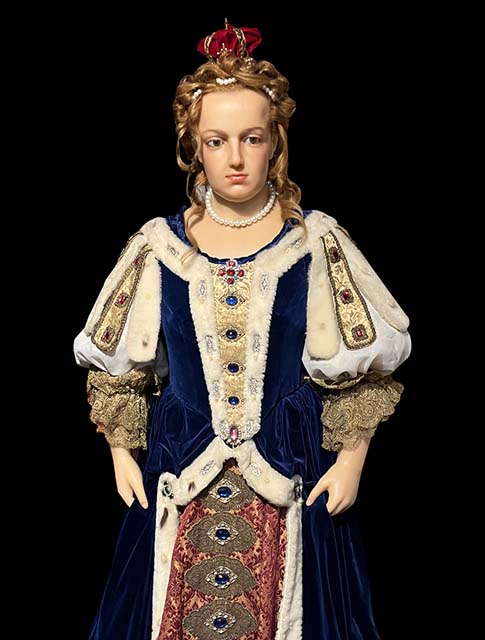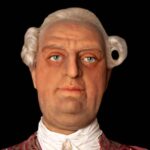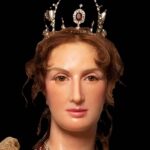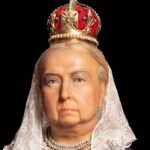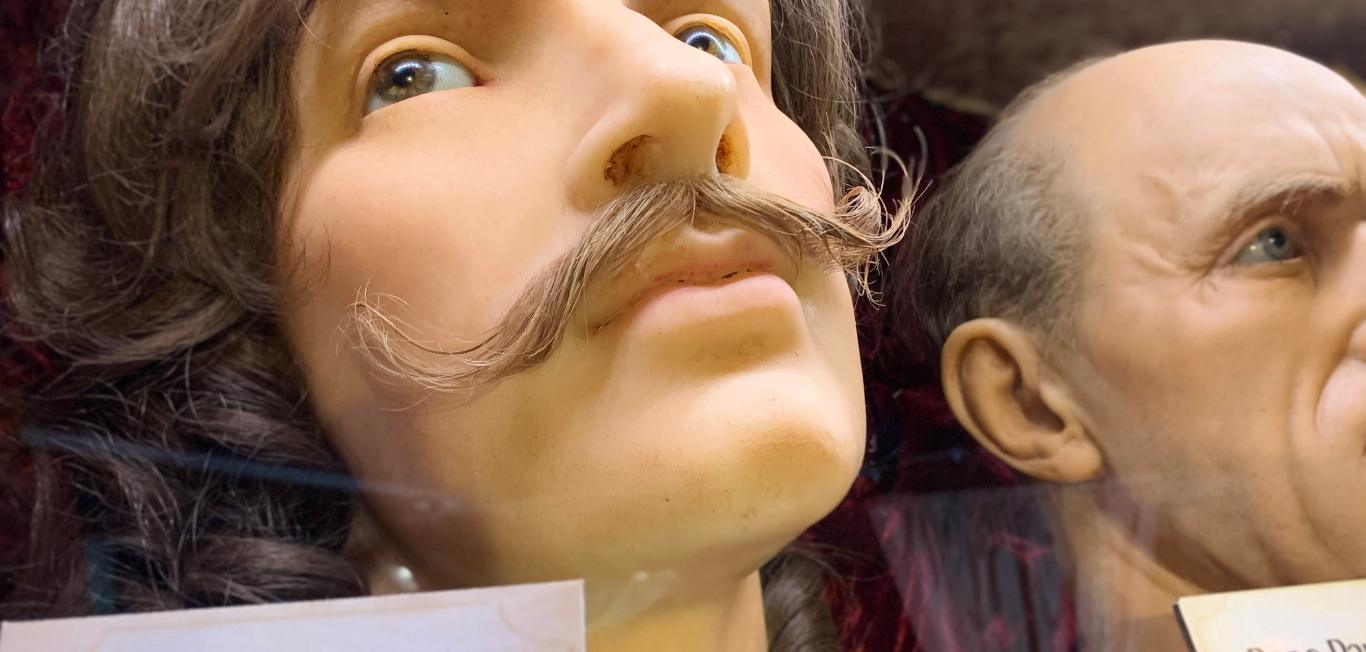Biography
Queen Anne is a prominent figure in British history. She reigned over Great Britain from 1702 to 1714. Anne was born in 1665, the daughter of James II, Duke of York, and Anne Hyde, and was fourth in line to the throne. Queen Anne had a tumultuous life, facing several challenges in her personal life and during her reign. In 1683, Anne married Prince George of Denmark. This union was an arranged marriage, but Anne and George developed true adoration for each other. Anne’s poor health significantly affected her personal life, as she was constantly ill and endured several miscarriages and stillbirths. She had five children survive childbirth. Four of the five died before the age of two, and the longest surviving child died at the age of 11. Because none of her children survived childhood, she had no heir, and the Stuart Dynasty would end with her.
On March 8, 1702, Anne ascended to the throne. She was the ruler of the three kingdoms of Great Britain: England, Ireland, and Scotland. Her achievement of the Acts of Union cemented her place in British history as a pivotal figure in the transformation of the nation. During her reign, Queen Anne was viewed as a weak, easily influenced leader. This perspective was a result of her reliance on court ministers to assist her with making decisions. This theory was later challenged, and historians have found that Queen Anne was more influential and successful than originally recorded.
Queen Anne died on August 1, 1714, after a series of strokes. Her ill health continued to worsen throughout her life, leaving her bedridden at the end. Her physician described her death as a merciful release. This biography notes the trials and triumphs of Queen Anne of England’s life and the events that made her an indelible part of British history.
Early Years of Queen Anne
Queen Anne was born on February 6, 1665, at London’s St. James’ Palace. She was the second daughter and the fourth child of Duke James II and Anne Hyde. From infancy, Anne experienced health complications that would remain until adulthood. She was fragile and suffered from an eye condition, defluxion, which caused frequent bouts of watery eyes. In an effort to mitigate her ailment, she was sent to live with her paternal grandmother and receive treatment in France. Unfortunately, her grandmother passed away in 1669, which resulted in Anne having to be moved to a new caretaker. After her grandmother’s passing, Anne was sent to live with her aunt, who ended up passing away the following year. As a result of this, Anne was sent back home to England, but the tragedy continued. Another year passed and, by the age of six, her mother died. This was only the beginning of the personal challenges Queen Anne would face throughout her life.
DID YOU KNOW?
From infancy, Queen Anne experienced health complications that would remain until adulthood.
Duke James II, Anne’s father, was a Roman Catholic. Under the rule of her uncle, King Charles II, everyone in the royal family was to adhere to the Protestant faith. This created tension between the two brothers, but the duke’s children were raised as Protestants out of respect for the king. In line with tradition, the children were removed from their father and placed into a separate household. The two sisters, Mary and Anne, were raised in Richmond, England. During her time in Richmond, Anne developed a friendship with Sarah Jennings (later Sarah Churchill), who would go on to stay by her side as both friend and advisor when Anne reigned as queen. The unfortunate events and religious rift Anne experienced in her childhood later played a significant role in her life and how she would rule as the queen of England.
Personal Life of Queen Anne
Queen Anne’s personal life was made up of enduring challenges. Her lifelong battle with chronic illness and the personal losses she experienced influenced her reign. Despite the challenges endured, she experienced happiness in her marriage to Prince George of Denmark, who provided Anne with solace and affection. With the support of her husband and the mental strength she developed from her tumultuous life, she left an indelible mark on British history and became a pivotal figure in the evolution of the British monarchy.
In the effort to provide an heir to the throne, Queen Anne experienced pregnancy 17 times. Unfortunately, due to her fragile physical condition, she faced a series of miscarriages and stillbirths. The children that did survive childbirth never made it to adulthood, with the longest-living child dying at the age of 11. The inability to provide the throne with a natural successor caused Queen Anne great sorrow.
Although the union of Queen Anne and Prince George was an arranged marriage, they were faithful and devoted to each other. Upon her ascension to the throne, she appointed her husband Lord High Admiral, giving him control of the Royal Navy and giving him a place in the royal court. George died in October of 1708, leaving the queen devastated. Until her death in 1714, Queen Anne’s life was filled with sadness and discontent.
Queen Anne Facts
The reign of William III and Mary II was one of the more well-known examples of Britain having joint ruling monarchs. They had no heirs, however, which meant Queen Anne would ascend to the throne when her sister, Queen Mary II, died. This event reinstated a single monarch in Britain.
Anne remained loyal to her Protestant faith and supported her cousin and sister’s plan to remove her father from the throne.
Queen Anne was the last Stuart to rule in British history. Her death was the conclusion of the enduring Stuart Dynasty.
Queen Anne married a Danish prince, George, who held the title of Lord High Admiral.
Queen Anne was pregnant 17 times. Most of her pregnancies resulted in stillbirths, and the ones who were born alive never survived to adulthood.
At the beginning of her reign, Queen Anne ruled over England, Scotland, and Ireland as three separate entities. By the end of her reign, she had successfully united the three territories, forming what we know today as Great Britain.
One of Queen Anne’s most notable legislative milestones was the Acts of Union, which transformed the political landscape of and strengthened the English kingdom by unifying England, Scotland, and Ireland.
One of the significant conflicts that occurred during Queen Anne’s reign was the War of the Spanish Succession.
During her reign, Queen Anne endured several political and military challenges, including learning how to navigate the intricate field of international diplomacy.
Anne developed two close friendships during her lifetime. Sarah Churchill was Queen Anne’s childhood friend, who would sit on the queen’s court and heavily influenced her. Abigail Masham, Sarah’s cousin, was appointed Lady of the Bedchamber. The queen and Abigail became so close that rumors began to circulate that they were in a relationship.
Glorious Revolution
On November 5, 1688, William of Orange, Anne’s brother-in-law, invaded England to depose King James II. This pivotal moment in British history is known as the Glorious Revolution of 1688. Up until the reign of King James II, England was ruled under the Protestant faith. When Anne’s uncle, King Charles II, died, her father was the next successor to the throne. Anne’s father, King James II, converted to Roman Catholicism in 1669. His change in religion caused controversy within the royal family upon his ascension to the throne.
The courts struggled to adapt to the changes made by King James II. His desire was to establish a court separate from parliamentary influence and to weaken the power of the Church of England, causing a stir of discontentment. Anne was raised as a Protestant, as required by King Charles II, and she maintained her faith, even if it meant going against her father, King James II. Plans to overthrow began to take shape in response to King James II appointing roles to Catholics and excluding Protestants.
DID YOU KNOW?
Queen Anne was raised as a Protestant, as required by King Charles II, and she maintained her faith, even if it meant going against her father, King James II.
King James II fled to France within two months of William of Orange’s invasion. In January 1689, an assembly occurred, effectively declaring King James II abdicated and the throne vacant. With the vacancy of the throne, William of Orange and Mary were jointly declared monarchs of England, Ireland, and Scotland. The Glorious Revolution and the appointment of new monarchs began a new course in British history. Anne would be the next successor to the throne, as William III and Mary had no children.
Ascension to the Throne
King William, Anne’s cousin and brother-in-law, and Mary, Anne’s sister, had no children, which left Anne as the natural successor to the throne upon their deaths. Queen Mary and Anne’s relationship was complicated and they grew further apart each year. Mary died from smallpox in 1694, leaving William to rule alone. After Mary’s death, King William and Anne reconciled. He reappointed her honors, titles, and privileges, and even gifted her her sister’s jewelry. Anne remained excluded from government affairs and could not act as regent in the absence of the king until his death on March 8, 1702.
Though Queen Anne easily became loved and popular, she was viewed as a weak decision-maker, susceptible to manipulation and incredibly trusting. Anne’s childhood friend, Sarah Churchill, remained close to the queen and held positions such as “Lady of the Bedchamber” and “Mistress of the Robes.” Churchill was wholly trusted by the queen but was not known to have Queen Anne’s best interests in mind. Her focus was on maintaining her status in the court, and she enjoyed frequently receiving gifts from the queen. Throughout Queen Anne’s reign, Sarah Churchill heavily influenced many decisions. This impacted the queen’s rule and contributed to the course of her reign.
Acts of Union
The Act of Settlement 1701 was a pivotal moment in British history and inspired the Acts of Union, which would go into effect in 1707. In the early 18th century, Ireland was under the English Crown’s authority and Wales was integrated into the English Kingdom under the Act of Settlement 1701. Scotland remained its own kingdom, maintaining its status as an independent sovereign state with its own legal system and parliament. In Scotland, there was a large number of Scots who were steadfast in upholding the Stuart Dynasty’s right of inheritance to the throne. This posed a challenge for ruling under a unified monarchy.
From the start of Queen Anne’s ascension to the throne in 1702, she recognized the need for a union between England and Scotland, which would complete the unification of the three kingdoms and form Great Britain. In her inaugural speech to the English parliament, Queen Anne voiced her support for this union. A commission of Anglo-Scots assembled to discuss the terms of this potential union at the Cockpit at Westminster. In 1707, the Acts of Union passed and marked a significant milestone in British history with the official unification of Great Britain.
Legacy of Queen Anne
What was once deemed a weak monarchy has earned a new reputation. Queen Anne’s reign was misunderstood and underrated. Through reevaluation and the challenging of perceptions, historians have found that she was actually a strong ruler. Queen Anne left a significant mark on British history through her ability to navigate the political field and elevate Britain’s military as a major land-based power.
Queen Anne’s most significant achievement was uniting Scotland and England through the Acts of Union. Under the Act of Settlement 1701, England and Ireland were united as part of the British kingdom. Uniting with Scotland was the final piece to forming Great Britain. Achieving the Acts of Union solidified Queen Anne as a pivotal figure in the evolution of the British monarchy. This union set the foundation for the prosperity and influence of the British kingdom and resulted in Great Britain becoming a dominant global power.
DID YOU KNOW?
Queen Anne's most significant achievement was uniting Scotland and England through the Acts of Union.
Death of Queen Anne
Queen Anne spent her life chronically ill. In fact, she experienced sickness from the day she was born in 1665. She passed away on August 1, 1714, marking the end of her reign as England’s monarch. Although Queen Anne spent her life overcoming perpetually ill health, personal tragedies, and reliance on her court for decision-making, she had notable achievements that had a global impact. Most importantly, she oversaw the Acts of Union, which united England, Scotland, and Ireland, forming Great Britain. Queen Anne’s cause of death was a series of strokes that she experienced on July 30, 1714. Her doctor, John Arbuthnot, expressed that her death was a merciful release from a life filled with physical ailments and sorrow, and compared it to a welcome sleep for a weary traveler. She was laid to rest beside her husband and children in the Henry VII chapel, located in the south aisle of Westminster Abbey.
FAQs
What is Queen Anne famous for?
Queen Anne is famous for the Acts of Union that unified England, Ireland, and Scotland into Great Britain. She was also the last ruler of the Stuart Dynasty.
When did Anne, Queen of Great Britain, rule?
Queen Anne’s reign was 1702-1714. She ascended to the throne on March 8, 1702, following the death of King William III, and her reign continued until her passing on August 1, 1714.
What disease affected Queen Anne?
Queen Anne suffered from various health issues throughout her life. Since birth, she suffered from an eye condition, defluxion, which caused frequent bouts of watery eyes. It is still unknown what the exact nature of her illness was.
Who was Queen Anne’s husband?
Queen Anne’s husband was Prince George of Denmark. They were married in 1683, and George became her devoted companion throughout her life. Anne had a deep affection for him. When Anne ascended to the throne, she gave him the title of Lord High Admiral.
Who inherited the throne after Queen Anne?
Queen Anne died August 1, 1714, and had no heir. Sophia of Hanover was elected to ascend to the throne, but she died weeks before Queen Anne. Therefore, Sophia’s son, George I, Elector of Hanover, became King George I of Great Britain. This transition marked the end of the Stuart Dynasty and the beginning of the Hanoverian era in British history.
